News Around NIDDK
Discovery documentary spotlights sickle cell research at NIH Clinical Center
By January W. Payne
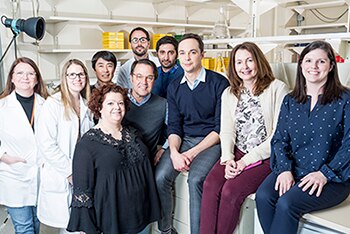
For a year, filmmakers for the Discovery Channel had an inside look at the important work done inside NIH's Clinical Center. The result of that effort, "First in Human," aired as a three-part documentary in August. The Big Bang Theory's Jim Parsons served as narrator and executive producer.
The documentary aimed to elevate people's understanding of the role, value, purpose and potential of NIH's clinical research. One researcher profiled was NIDDK Senior Investigator Dr. John Tisdale, a hematologist. He has spent his career studying sickle cell disease (SCD), an inherited disorder in which curved cells block blood flow. It can cause severe pain, organ damage and death.
"In the 1970s, a child born with sickle cell disease might not even experience life past high school," Tisdale said. "Life expectancy has improved—though not enough—over the last several decades, thanks to research that NIH has funded." The documentary features Tisdale's newer, still experimental cell and gene therapy treatments for people with SCD.
Tisdale was also involved in pivotal research around hydroxyurea, the first and only FDA-approved drug to treat sickle cell disease. This work was conducted at the NIH Clinical Center and led by now-NIDDK Director Dr. Griffin P. Rodgers, and other researchers.
"At NIH, we're making discoveries that directly benefit Americans and people around the world. It's a privilege to work where so many passionate experts from across many biomedical disciplines can congregate to share expertise and ask questions in new ways," Rodgers said. "The NIH campus has been the site—and perhaps even the catalyst—of so many life-changing advances. One of the great advantages of the Clinical Center is that we see patients and have labs in the same building, helping ensure we never lose sight of the people we're serving, even as we delve deep into platelets and probabilities."
Among the many advances made at the NIH Clinical Center, some of the most notable include the discovery of biomarkers for cardiovascular disease, developing the first drugs to treat HIV and AIDS, using immune therapy for metastatic melanoma, and testing the first in human Ebola vaccines in addition to new vaccines for malaria, influenza and Zika, according to an NIH news release.
"One of the things you see in this documentary is the passion and care these doctors work with," said Parsons to Jimmy Kimmel during an appearance on Kimmel's show. Clinical center volunteers "know that they're making a contribution … to coming closer to finding a cure. It's the most beautiful, moving thing in the world, and it's such important work."
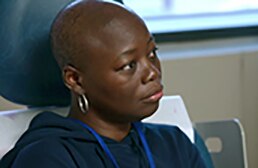
"For thousands of patients around the world, NIH is known as the National Institutes of Hope and I am delighted that Discovery's series will educate the public on the bravery of our volunteer patients who are our partners in scientific discovery," said NIH Director Dr. Francis S. Collins, in a news release. "This film depicts, in a very poignant way, the difficult decisions faced by many suffering from disease and the profound contribution of research participants to improving treatments for all."
The NIH launched a "First in Human"-related webpage that includes details about the Clinical Center and information about clinical trials, health information, and more. Discovery channel and NIH, also hosted a Twitter chat on Aug. 9 using the hashtag #FirstinHuman to discuss the documentary and the importance of clinical trials. Episodes may be viewed on Discovery's website with credentials for any of the television providers listed on the site.
As DCCT/EDIC looks to 35 years, researchers study effect of T1D on aging
By Amy F. Reiter
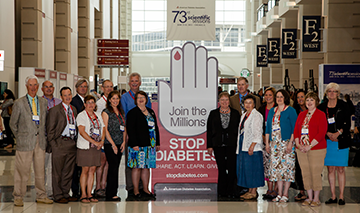
When the Diabetes Control and Complications Trial (DCCT) began in 1983, some of its 1,441 participants may have had to consider curfews or worry about a pop quiz. Now, nearly 35 years later, their lives have changed – and so has the focus of the landmark research they've helped make happen.
"We've been working with this unique group for a huge portion of their lives, and what they've helped us learn about treating type 1 diabetes has become the standard of care worldwide," said Dr. Catherine Cowie, the NIDDK program director overseeing DCCT and its follow-up, the Epidemiology of Diabetes Interventions and Complications (EDIC) study. "Now, as they age, we're able to learn about the effects of type 1 diabetes—and the role of early intensive blood glucose management—over the long haul."
Over the next five years, EDIC is expanding its emphasis to look at complications related to aging. The researchers will examine the prevalence of cognitive and physical impairments in people with type 1 diabetes. They'll use brain MRIs to assess brain structure and function as compared to people without type 1 diabetes in a control group. The researchers will also examine effects of early blood glucose control, hypoglycemia and other factors on the brain.
EDIC researchers are just completing a study on T1D and hearing loss. As well, the researchers will look at mood disorders like depression and at bone health, including fractures—which occur more often in people with T1D. Researchers will analyze risk factors for these and other conditions in people with type 1 diabetes. The studies will examine how these conditions affect quality of life, disability, and other factors, along with the economic cost of T1D.
Using new technology, an EDIC ancillary study has just begun where participants will be monitored simultaneously by electrocardiogram (ECG), continuous glucose monitoring and a Fitbit to try to understand how hypoglycemia may cause arrhythmia, which is suspected as a cause of sudden unexpected death during sleep.
DCCT/EDIC has been producing pivotal results throughout its tenure, including the recent study looking at risk of developing eye disease severe enough to require treatment to prevent vision loss. These study data were used to develop an individualized eye exam schedule for people with T1D which overall resulted in fewer exams, lower costs and earlier diagnosis of severe retinopathy.
When DCCT began, its participants were ages 13-39. Half were assigned at random to intensive blood glucose treatment designed to keep blood glucose as close to the non-diabetic range as safely as possible, and half to the conventional treatment at the time. In 1993, the intensive treatment group was found to have substantially less eye, nerve and kidney disease.
During EDIC, the original intensive treatment group has continued to show a long-term benefit, including longer lives, with reduced development of kidney disease, severe eye problems, heart disease and stroke. The control group, who were taught the intensive therapy immediately following DCCT, may have benefitted as well from earlier intervention. Researchers continue to track both groups for these complications and aim to examine their long-term effects in this new phase of research.
"None of this would be possible without the dedication of this amazing group of participants, with 94 percent of the original members still active in the study," said NIDDK Director Dr. Griffin P. Rodgers. "Thanks to them, their families, and DCCT/EDIC's devoted medical staff, we're looking forward to the next results from this transformative research and its dynamic team."
Getting to know: Dr. Tracy Rankin
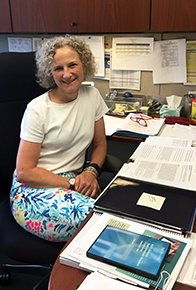
Dr. Tracy Rankin was recently named deputy director for clinical research in the NIDDK Division of Kidney, Urologic, and Hematologic Diseases (KUH). She is director of Career Development and Training for KUH, overseeing awards that support early training in both basic and clinical research related to kidney and benign urologic diseases. Rankin spoke with January Payne about her diverse career.
What led you to work at the NIH?
I had an undergraduate biology degree with a chemistry minor from the University of Virginia. As an undergraduate, I worked on a project to develop better rape detection kits in a lab, focusing on how to forensically target human sperm. Then I earned a Ph.D. from Vanderbilt University in cell biology, with a focus on reproductive biology.
After an intramural fellowship at NIH, I worked at the National Institute of Child Health and Human Development for seven years as an extramural program officer overseeing grant portfolios related to male reproductive health.
I was very interested in working with and training young people. Nine years ago, when KUH Director Dr. Robert Star recruited me to oversee career development and training, I jumped on a steep learning curve of renal physiology. The cell biology is similar to what I was familiar with in terms of the transporters and channels because sperm and reproductive tissues have those. However, the physiological aspects were a little daunting, so I still have my cheat sheets.
Have you pursued additional education or training since returning to NIDDK?
In 2016, I went back to school and earned a Master of Public Health online from George Washington University (GWU). I oversee a training portfolio of all things kidney, from cell biology to epidemiology and social science aspects of renal disease. I went back to school to gain an appreciation for population health and epidemiology and, particularly, some of the social science aspects. I'm looking forward to using this knowledge in my new role as deputy director for clinical research, where I'll work with staff and grantees on a wide variety of subjects.
What are you most proud of in your work at NIH?
It is hard to choose. What really comes to mind: I call it the microbiome effect—what my gut says—is that I'm good at connecting with people. I let training program participants know they have someone they can call at NIH with questions. Establishing that I am a resource for young people in the renal and urologic community is probably at the top of the list of what I'm most proud of.
What is your hope for progress in scientific training programs?
We have challenges in recruiting people into science, particularly physician-scientists who want to engage in basic science. Over the next 10 years, it would be quite wonderful to bend those curves back again, to really come up with career development training programs designed to fit the new way of science. Team science is the way now—you can't solve the complexity of human disease all by yourself. We have to put all the pieces together, and it's going to take a lot of interdisciplinary work.
What is your advice for young people interested in a research career?
Don't give up. A scientific career is rewarding on many levels. When you are at the bench, you never know what you're going to discover. The next day you walk into the lab could be when you get data you need for that high-impact paper you're working on. That's the prize, and these endeavors can change someone's life.
NIDDK director speaks to Congress on type 1 diabetes research
By Dr. Rebecca Cerio
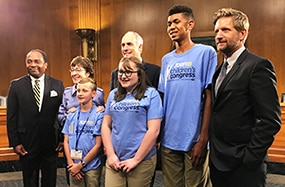
On July 26, NIDDK Director Dr. Griffin P. Rodgers testified about progress in type 1 diabetes research before the Senate Special Committee on Aging, led by Chairman Susan Collins (R-ME) and Ranking Member Bob Casey (D-PA). The hearing, "Progress Toward a Cure for Type I Diabetes: Research and the Artificial Pancreas," was held in conjunction with the Children's Congress, an event sponsored by JDRF (formerly the Juvenile Diabetes Research Foundation).
Testifying with Rodgers were actor and patient advocate Paul Sparks, who was diagnosed with type 1 diabetes at age 28; Angie Platt, the 2017 JDRF Children's Congress Family Chair; and Children's Congress delegates Charlie Albair, 10; Lorynn Watt,17; and Jonathan Platt, 14.
"Biomedical research has led to dramatic improvements in the health and quality of life of people with type 1 diabetes," Rodgers testified, describing recent advances in type 1 diabetes research, including efforts supported by the Special Statutory Funding Program for Type 1 Diabetes Research. "With continued research, it is possible to imagine that people could lead a life free of the burden of type 1 diabetes and its complications."
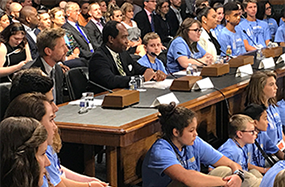
Rodgers' full testimony is available here on the NIDDK website, and more about the Programcan be found here.
On July 20, Rodgers participated in a Congressional Diabetes Caucus briefing hosted by Caucus co-chairs Representatives Diana DeGette (D-CO) and Tom Reed (R-NY). Also presenting at the event were NIH grantees Dr. Neil Bressler and Dr. Edward Damiano, and patient advocate Tim Ryan.
Rodgers described how the Special Diabetes Program has been used to develop major type 1 diabetes research efforts, including studies to determine genetic and environmental causes of the disease, test prevention strategies, replace lost insulin-producing cells, improve blood glucose management, and prevent and treat diabetic complications. Rodgers highlighted how this research has improved the lives of those living with type 1 diabetes.

